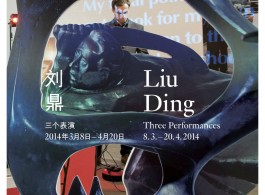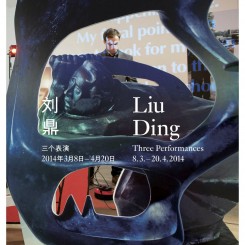Galerie Urs Meile is pleased to announce the opening of Liu Ding’s latest solo exhibition Three Performances. Over the past two years, Beijing-based artist Liu Ding(* 1976 in Changzhou, Jiangsu Province, China) has been developing a form of art that he terms “weak performance.” The three artworks—I Simply Appear in the Company of… (2012), The Un-erasable (2012), and Almost Avant-Garde (2013)—employ various perspectives to address the links between artistic practice and our experience, consciousness and contexts. Liu Ding’s work explores how these relationships can be perceived, described and expressed in art. I Simply Appear in the Company of… is a staged conversation about Liu Ding’s own practice between a Mr. Liu (played by Liu Ding himself) and two curators. The Un-erasable features Liu and an art historian carrying out a conversation about artistic practice and the experience of perception in a booth built inside the exhibition space. They were surrounded by artworks Liu Ding had collected over the years, which evoked common aesthetic experiences. Without the use of microphones, which was an intentional setup, the performers’ conversation is barely audible, and the audience is only able to grasp fragments of it.
These two performances did not take place in isolation. They both arose out of specific art contexts and integrated themselves into the very circumstances they are situated in. I Simply Appear in the Company of… was a performance that took place in the form of an artist talk that was built into a one-day symposium held at Tate Modern’s Oil Tanks. The Un-erasable was shown at the 8th Taipei Biennial (2012). It was composed of two performances, one on the day before the opening as an integral part of the installing process, and one on the opening ceremony and as part of the opening ceremony. To Liu Ding, “weak performance” is not an art form that requires strict definition. Yet compared with the tradition of performance art, which involves developing highly symbolic personas, Liu Ding’s weak performances tend to involve Liu playing himself and relating his real thoughts, experiences, and frustrations as an artist on camera.
Liu Ding’s work often speaks out about those seemingly self-evident aspects current in our immediate surroundings and our own experience. He seeks to re-examine existing structures, narratives and consciousness, whether they are related to art history or they are those repeatedly celebrated and defined by the industry. Instead of affirming the pre-existing confrontational roles between art and the reality, Liu Ding intends to reconsider the relevance of these real-life relationships towards art. Clues and relationships are like two sides of the same coin in Liu Ding’s works. He often describes his artistic practice as being like a detective at work: a detective should be fully immersed in the act of investigation, and should put oneself in the shoes of the criminal. One needs to break down the power of time, to sharpen one’s instinct and imagination, as well as to shoulder the responsibility in reality. All of these aspirations bring to mind the position and anxiety of a practitioner in the process of creation.
Being invited by Catherine Wood, curator of BMW Tate Live performance series to create a piece for the series, Liu Ding made Avant-Garde, which took place within an enclosed space, and was a live broadcast designed solely for an online audience. In this work, Liu Ding invited art professionals and colleagues of Tate Modern to a party held in a room decorated with cardboard reproductions of modern pieces of art from the museum’s permanent collection. During the performance, a number of baroque soundtracks that Liu Ding had moderated subtly are being played by a DJ. The conversations on set are hardly audible in the film and the shooting was frequently interrupted by streaming of texts on the screen, taken from Liu Ding’s interviews with an older generation of Chinese artists and curators active during the 1990s. In such an environment as in China where the basis for discussions can never seem to be established, things always appear “almost avant-garde”, with newer and newer historical horizons awaiting for us in the distant future. Liu Ding’s work questions this kind of ambiguous and mediocre reality of art and the populist attitude embodied in it. Liu Ding strives to closely survey the reality on a microscopic level, including those that are barely identifiable and hardly sensible at the first glance. Just as in the salon in Almost Avant-Garde, even when we fail to clearly describe what is happening there and then, those lively relationships among what was present still provide an intense sense of time, motivations and the promise of realness.
Over the past few years, Liu Ding has been making new works, curating, publishing, lecturing and actively engaging himself in other forms of theoretical practices, all of which contribute to a multi-faceted and dynamic system of practice. Within the context of the art industry in China, Liu Ding has initiated a critical approach rooted in the history of ideas, to investigate the prospect of artistic practice in the context of art history and in the logic of the art system. In his work, he re-evaluates and reflects critically on the relationship between artistic practice and the value system surrounding it. In 2014, he has been invited to take part in the New Orleans Biennial, for which he plans to create a new work in the line of “weak performance”.
Liu Ding was born in Changzhou, Jiangsu province in 1976. He’s now based in Beijing and is both an artist and a curator. His work has been shown at a number of art institutions including the Tate Modern, Turner Contemporary, both London, UK; Arnolfini – Contemporary Arts Center, Bristol, UK; the Kunsthalle Wien, Vienna, Austria; the Astrup Fearnley Museum of Modern Art, Oslo, Norway; the São Paulo Museum of Art, São Paulo, Brazil; the ZKM, Zentrum für Kunst und Medientechnologie, Karlsruhe (ZKM), Germany; the Centre PasquArt, Biel, Switzerland; the Fondazione Sandretto Re Rebaudengo, Turin, Italy; the Seoul Museum of Art, Seoul, South Korea; the Luggage Store Gallery, San Francisco, USA; the Frye Art Museum, Seattle, USA; the Iberia Center for Contemporary Art, Beijing, China; the Museum of Contemporary Art Shanghai, China; and the Taipei Fine Arts Museum, Taipei, China. He took part in the 2012 Taipei Biennial, the exhibition at the Chinese Pavilion at the 2009 Venice Biennial, the 2008 Seoul International Media Art Biennale, and the 2005 Guangzhou Triennial. With Carol Yinghua Lu, he exhibited Little Movements: Self-Practice in Contemporary Art in September 2011 at OCT Contemporary Art Terminal, Shenzhen, China. In 2013, the work went on tour and was exhibited at MUSEION in Bolzano, Italy. In 2012, Liu Ding served as a curator of the Seventh Shenzhen Sculpture Biennale – Accidental Message: Art is not a System, not a World. Works which he has written and published include Little Movements: Self-practice in Contemporary Art (Guangxi Normal University Press, 2011), Little Movements II: Self-practice in Contemporary Art (Walther König, 2013), Accidental Message: Art is not a System, not a World (Lingnan Art Publishing House, 2012), and Individual Experience: Conversations and Narratives of Contemporary Art Practice in China from 1989 to 2000 (Lingnan Art Publishing House, 2013).
Text/Su Wei


